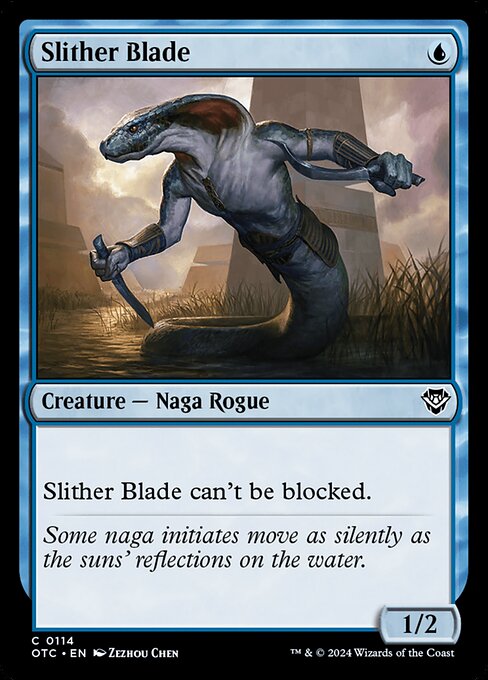
Image courtesy of Scryfall.com
Artful Unblockables: Slither Blade Across Reprint Art
Blue mana has a way of sneaking under the radar, and Slither Blade is a perfect showcase of that quiet, precise magic. When you compare its card art across reprints, you’re watching a dialogue between designers, artists, and players who adore the tension between elegance and edge. The recent Outlaws of Thunder Junction Commander version, illustrated by Zezhou Chen, keeps the water-centric, stealthy vibe that makes the card instantly recognizable in any blue tempo deck. 🧙♂️🔥💎
What stands out at first glance is the way Chen emphasizes serpentine grace and watery atmosphere. The original art (and other reprints in different frames) tend to place Slither Blade in environments that whisper “quiet approach” rather than “flashy ambush.” Chen’s interpretation uses cool blues and a tight linework that gives the blade-like snake a silvery gleam, as if the surface of the water itself could reflect a glint from the blade. The result is a depiction that feels both intimate and dangerous, which is exactly how blue’s tempo plan wants to operate: you threaten a strike, then slip away before your opponent can react. 🎨
Flavor text—“Some naga initiates move as silently as the suns' reflections on the water.”—reminds us that this creature’s strength isn’t raw power, but precise, patient inevitability.
Across reprints, you’ll notice subtle shifts in color grading, background details, and the balance between subject and environment. In the OTC Commander version, the artwork is framed to emphasize the snake’s sinewy motion and the glint of blue on its scales. Some earlier prints may lean a touch warmer or place the snake in a slightly more vignette-lit scene. These changes aren’t just cosmetic; they affect how you experience the card in hand or on the battlefield. Do you sense the water’s depth behind the rogue, or does the focus feel more tightly on the creature itself? Each edition nudges your impression in a distinct direction, much like how different printer runs alter details in a foil or nonfoil card. 💎
For collectors, the reprint status signals a practical shift as well. Slither Blade lands in the common slot, which means it’s accessible for budget builds and curious collectors alike. The OTC set’s Commander emphasis adds a conversational layer to how the card is used: it’s not a marquee bomb, but a reliable, understated tool for blue strategies. The official data set confirms a humble power of 1 and toughness of 2 (a 1/2 for enablement and evasion), with a mana cost of {U}. In play, that translates to tempo plays, where your opponent’s blockers suddenly become non-factors—unleash unblockable pressure while you bend the game to your rhythm. ⚔️
The visual trade-off between reprints is also a reminder of how MTG art evolves alongside game design. Slither Blade’s identity—cool, calculating, and a touch mystical—remains intact, even as the environment around it shifts with each printing. The artist behind this particular rendition, Zezhou Chen, brings a crisp digital finish that feels modern while nodding to the timeless discipline of stealth. You can sense the card’s lore, too: a naga initiate whose movements are as quiet as reflections on a moonlit pool. This pairing of lore and art is what keeps reprints relevant, inviting players to rediscover a familiar card with fresh eyes. 🧙♀️
When you’re building a deck around Slither Blade, the art matters because it anchors the narrative you’re telling at the table. A blue tempo plan loves the illusion of inevitability—the kind of card that makes your opponent second-guess every attack. The ability text—“This creature can't be blocked.”—isn’t just a rule; it’s a storytelling hook. The artwork reinforces that hook: you feel like you’re watching a silent predator glide along a reflective surface, choosing its moment. In this sense, reprints become not just copies, but reinterpretations of the same moment: the moment when the blade becomes unavoidable and the game turns on a single, elegant decision. 🧙♂️⚔️
For fans who appreciate the craft behind MTG’s visuals, reprints are a delightful study in how a card ages with style. The OTC version preserves the assassin’s allure while inviting players to notice the nuances in Chen’s brushwork and shading. If you’re a table curator who loves comparing frames, or a player who values the table presence of an unblockable threat, Slither Blade is a flagship example of how a small blue card can carry big, quiet drama. And if you’re settling in for a session, you’ll appreciate how a steady, slipstream attack feels just as satisfying as landing with a big, flashy spell. 🧲🎲
As you hunt for copies, consider the nonfoil print you’ll likely encounter—the market sees Slither Blade hover in a modest price range, roughly around USD 0.27 (EUR around 0.26). It’s a pragmatic buy with strong flavor and solid game impact, especially in casual and Commander circles where its unblockable efficiency can swing games in surprising ways. The reprint also serves as a reminder that good art isn’t about outshining the text; it’s about elevating the moment between a player’s plan and the moment when the opponent realizes the path to victory was hiding in plain sight all along. 🧙🔥
For readers seeking more from our network, check out the cross-posts below and dive into related topics—from digital product insights to deep dives into classic and modern MTG debates. And if you’re shopping while you read, this mouse pad pairing feels almost thematic: a steady, reliable surface that keeps your focus where it belongs—on the game. 🧩
Non-Slip Gaming Mouse Pad Polyester Surface Anti-Fray EdgesMore from our network
- https://blog.digital-vault.xyz/blog/post/create-a-digital-product-that-solves-real-problems/
- https://blog.digital-vault.xyz/blog/post/blue-white-giant-star-reveals-stellar-mass-temperature-link/
- https://crypto-acolytes.xyz/blog/post/top-dreamcast-adventure-games-you-need-to-play/
- https://transparent-paper.shop/blog/post/how-to-analyze-social-media-metrics-like-a-pro/
- https://crypto-acolytes.xyz/blog/post/best-horror-dlcs-of-all-time-that-still-terrify/